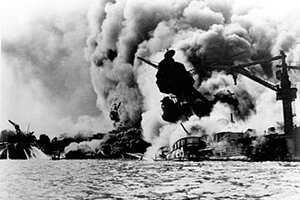Pearl Harbor Day 2009: three enduring mysteries
On Pearl Harbor Day 2009, here is a look at lingering questions such as: How did the Japanese fleet get so close to Hawaii without being spotted?

In this Dec. 7, 1941 file photo provided by the US Navy, the USS Arizona is pictured in flames after the Japanese attack on Pearl Harbor. The attack sank four US battleships and destroyed 188 US planes. More than 2,200 sailors, Marines and soldiers were killed.
US Navy, File/AP
Washington
How did the Japanese do it? That question remains 68 years after the attack on Pearl Harbor, a day that spawned some of the greatest unanswered questions of US military history.
The completeness of the surprise, as well as the enormity of the attack's destruction, have led conspiracy theorists to surmise that President Franklin D. Roosevelt must have known what was coming, and allowed it, to rouse the nation for World War II.
Most historians don't believe that. The conspiracy theorists generally premise their arguments on the notion that the United States had broken the codes of the Japanese navy and thus knew its carriers were steaming toward Hawaii. But that's not true, according to Robert J. Hanyok, a former historian with the US National Security Agency.
In 1941, US code breakers had made only minimal progress in understanding encrypted Japanese navy messages, Mr. Hanyok writes in a recent Naval History magazine article.
"No intelligence about Pearl Harbor could come from this source," he writes.
A better explanation for the enormity of the US defeat might be that the attack was a so-called black swan event: something so far outside the realm of expectations that Americans could not conceive of it occurring.
This was true even of American servicemen looking at hints of what was coming their way.
"It just wasn't in their frame of reference," says naval historian Lawrence H. Suid.
Today, a number of what-ifs, or enduring mysteries, about the Pearl Harbor attack continue to inspire debate. Among them:
Why didn't the US see Japanese planes coming on radar? Actually, US Army radar operators did spot the Japanese air assault on radar. They just did not know what they were seeing.
Radar technology was in its infancy, and an Army crew was training on a new radar installed at the northern point of the Hawaiian island of Oahu. On Dec. 7, 1941, this crew spotted a mass of incoming somethings larger than they had ever seen. They decided it was probably some expected US B-17s and reported it as such.
But the radar return looked much different from what they were used to seeing.
"Why didn't this stir up their curiosity?" Suid says.
Why did the US Navy ignore the sinking of a Japanese submarine prior to the attack? At 6:37 on the morning of Dec. 7, the USS Ward, an old four-stack destroyer, attacked and destroyed a Japanese mini-sub making its way toward Pearl Harbor.
Crew members of the Ward saw a submarine periscope, dropped depth charges, and saw an oil slick and debris indicating they had destroyed a target. They immediately sent a dispatch saying that they had destroyed "a submarine operating in defense sea areas," according to a copy of the ship's report of the attack.
This incident took place an hour prior to the arrival of the first wave of Japanese warplanes. But US military officials did not heed the warning provided by the Ward, or did not believe it, or simply were unable to react in time.
Three years later to the day, on Dec. 7, 1944, the Ward was sunk by a Japanese kamikaze air attack off the island of Leyte.
How did the Japanese fleet get so close to Hawaii without being spotted? The Japanese military's attempts to deceive its US counterparts as to where Japan's carriers were in early December 1941 succeeded to a remarkable degree.
A radio ruse contributed greatly to this success. Beginning in mid-November, the Japanese ships pretended to be continuing with a routine communications drill – knowing that all the while US eavesdroppers were listening in.
They then followed with a week of only occasional chatter, leading US analysts to believe that the carriers had entered home waters for rest. Instead, they were steaming toward Hawaii.
Japanese operational security prior to the fleet's departure had been so tight that at least one foreign ship approaching a Japanese navy training area had been boarded and seized. Fleet plans for the month of December had been printed without an annex detailing the destination of Hawaii. Even senior Japanese officers weren't told of the attack until the last possible moment.
In the end, the Japanese achieved almost complete tactical surprise. And in that might lie the key to understanding Pearl Harbor, writes Hanyok, the former NSA historian.
The key could be not the surprise per se, but the skill of the Japanese. Most US analyses of Pearl Harbor probe for American mistakes, or they at least see the attack in an American frame of reference.
"But the key to understanding why the surprise assault was so successful lies in realizing what the Japanese did right," according to Hanyok.
[Editor’s note: The original version cited the wrong year twice.]
-----
Follow us on Twitter.
